| Listing 1 - 10 of 10 |
Sort by
|
Periodical
Abstract | Keywords | Export | Availability | Bookmark
 Loading...
Loading...Choose an application
- Reference Manager
- EndNote
- RefWorks (Direct export to RefWorks)
Educational technology --- Computer-assisted instruction --- Computer-assisted instruction. --- Educational technology. --- Instructional technology --- Technology in education --- CAI (Computer-assisted instruction) --- Computer-aided instruction --- Computer-assisted learning --- Computer based instruction --- Computer-enhanced learning --- Electronic data processing in programmed instruction --- ILSs (Integrated learning systems) --- Integrated learning systems --- Microcomputer-aided instruction --- Microcomputer-assisted instruction --- Microcomputer-assisted learning --- Microcomputer-based instruction --- Teaching --- Data processing --- Technology --- Educational innovations --- Instructional systems --- Education --- Programmed instruction --- Telematics --- Aids and devices
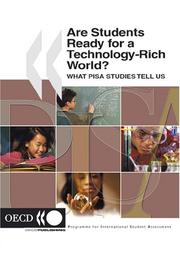
ISBN: 1281746916 9786611746919 9264036091 9264036083 Year: 2006 Publisher: Paris : OECD,
Abstract | Keywords | Export | Availability | Bookmark
 Loading...
Loading...Choose an application
- Reference Manager
- EndNote
- RefWorks (Direct export to RefWorks)
ICT has profound implications for education, both because ICT can facilitate new forms of learning and because it has become important for young people to master ICT in preparation for adult life. But how extensive is access to ICT in schools and informal settings and how is it used by students? Drawing on data from the OECD’s Programme for International Student Assessment (PISA), Are Students Ready for a Technology-Rich World? What PISA Studies Tell Us, examines whether access to computers for students is equitable across countries and student groups; how students use ICT and what their attitudes are towards ICT; the relationship between students’ access to and use of ICT and their performance in PISA 2003; and the implications for educational policy.
Science and Technology --- Education --- Computer-assisted instruction --- Educational technology --- Social Sciences --- Theory & Practice of Education --- Computer-assisted instruction. --- Educational technology. --- Instructional technology --- Technology in education --- CAI (Computer-assisted instruction) --- Computer-aided instruction --- Computer-assisted learning --- Computer based instruction --- Computer-enhanced learning --- Electronic data processing in programmed instruction --- ILSs (Integrated learning systems) --- Integrated learning systems --- Microcomputer-aided instruction --- Microcomputer-assisted instruction --- Microcomputer-assisted learning --- Microcomputer-based instruction --- Teaching --- Data processing --- Technology --- Educational innovations --- Instructional systems --- Programmed instruction --- Telematics --- Aids and devices
Book
ISBN: 9264024344 9264024336 Year: 2006 Publisher: Paris : OECD,
Abstract | Keywords | Export | Availability | Bookmark
 Loading...
Loading...Choose an application
- Reference Manager
- EndNote
- RefWorks (Direct export to RefWorks)
Die Informations- und Kommunikationstechnologie (IKT) bringt eine beispiellose weltweite Flut von Informationen, Produkten, Personen, Kaptital und Ideen hervor, indem sie riesige Netzwerke von Individuen über geographische Grenzen hinweg zu verschwindend geringen marginalen Kosten miteinander verbindet. IKT ist ein wichtiger Bestandteil der Politikagenda der OECD-Länder mit tiefgreifenden Auswirkungen für die Bildung, einmal weil IKT neue Formen des Lernens erleichtern kann und zum anderen weil es für junge Menschen im Hinblick auf ihr späteres Leben heute unerlässlich ist, IKT zu beherrschen. Aber in welchem Maße haben die Schüler Zugang zu IKT im schulischen und außerschulischen Bereich und wie machen sie davon Gebrauch?Der Bericht untersucht folgende Aspekte: Die Frage, ob der Zugang, den die Schüler zu Computern haben, im Ländervergleich und zwischen verschiedenen Schülergruppen gleichmäßig verteilt ist. Die Frage, wie die Schüler IKT nutzen und wie ihre Einstellung hierzu ist. Den Zusammenhang zwischen IKT-Zugang und -Nutzung der Schüler und ihren Leistungen in PISA 2003. Die Implikationen für die Bildungspolitik.
Computer-assisted instruction. --- Educational technology. --- Electronic books. -- local. --- Education --- Social Sciences --- Theory & Practice of Education --- Instructional technology --- Technology in education --- CAI (Computer-assisted instruction) --- Computer-aided instruction --- Computer-assisted learning --- Computer based instruction --- Computer-enhanced learning --- Electronic data processing in programmed instruction --- ILSs (Integrated learning systems) --- Integrated learning systems --- Microcomputer-aided instruction --- Microcomputer-assisted instruction --- Microcomputer-assisted learning --- Microcomputer-based instruction --- Teaching --- Data processing --- Technology --- Educational innovations --- Instructional systems --- Educational technology --- Programmed instruction --- Telematics --- Aids and devices
Periodical
ISSN: 17937078 Year: 2006 Publisher: [S.l.] Asia-Pacific Society for Computers in Education
Abstract | Keywords | Export | Availability | Bookmark
 Loading...
Loading...Choose an application
- Reference Manager
- EndNote
- RefWorks (Direct export to RefWorks)
Educational technology --- Computer-assisted instruction --- Educational Technology --- Learning & Instruction --- Computer-assisted instruction. --- Educational technology. --- Instructional technology --- Technology in education --- Technology --- Educational innovations --- Instructional systems --- Teaching --- CAI (Computer-assisted instruction) --- Computer-aided instruction --- Computer-assisted learning --- Computer based instruction --- Computer-enhanced learning --- Electronic data processing in programmed instruction --- ILSs (Integrated learning systems) --- Integrated learning systems --- Microcomputer-aided instruction --- Microcomputer-assisted instruction --- Microcomputer-assisted learning --- Microcomputer-based instruction --- Education --- Programmed instruction --- Telematics --- Aids and devices --- Data processing --- educational technology --- learning & instruction --- Computer. Automation
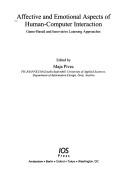
ISBN: 6610505128 1280505125 9786610505128 1423797302 160750149X 6000003374 1601291299 9781423797302 9781601291295 9781586035723 158603572X 9781607501497 Year: 2006 Publisher: Amsterdam Washington, DC IOS Press
Abstract | Keywords | Export | Availability | Bookmark
 Loading...
Loading...Choose an application
- Reference Manager
- EndNote
- RefWorks (Direct export to RefWorks)
The learning process can be seen as an emotional and personal experience that is addictive and motivates learners to proactive behavior. Divided in three parts, this title discusses major topics such as: emotions, motivation, games, and game-experience.
Computer-assisted instruction. --- Learning --- Experiential learning. --- Education --- Computer games --- Application software --- Electronic games --- Technological innovations --- Experience-based learning --- Learning, Experiential --- Experience --- Active learning --- Learning process --- Comprehension --- CAI (Computer-assisted instruction) --- Computer-aided instruction --- Computer-assisted learning --- Computer based instruction --- Computer-enhanced learning --- Electronic data processing in programmed instruction --- ILSs (Integrated learning systems) --- Integrated learning systems --- Microcomputer-aided instruction --- Microcomputer-assisted instruction --- Microcomputer-assisted learning --- Microcomputer-based instruction --- Teaching --- Educational technology --- Programmed instruction --- Telematics --- Research. --- Effect of technological innovations on. --- Simulation methods. --- Data processing --- Internet games --- Television games --- Videogames --- Games --- Video games
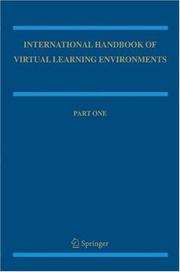
ISBN: 1281134333 9786611134334 1402038038 140203802X 9781402038020 Year: 2006 Publisher: Dordrecht Springer
Abstract | Keywords | Export | Availability | Bookmark
 Loading...
Loading...Choose an application
- Reference Manager
- EndNote
- RefWorks (Direct export to RefWorks)
What is virtual reality and how do we conceptualize, create, use, and inquire into learning settings that capture the possibilities of virtual life? The International Handbook of Virtual Learning Environments was developed to explore Virtual Learning Environments (VLE’s), and their relationships with digital, in real life and virtual worlds. Three issues are explored and used as organizers for The Handbook. First, a distinction is made between virtual learning and learning virtually. Second, since the focus is on learning, an educational framework is developed as a means of bringing coherence to the available literature. Third, learning is defined broadly as a process of knowledge creation for transforming experience to reflect different facets of "the curriculum of life". To reflect these issues The Handbook is divided into four sections: Foundations of Virtual Learning Environments; Schooling, Professional Learning and Knowledge Management; Out-of-School Learning Environments; and Challenges for Virtual Learning Environments. A variety of chapters representing different academic and professional fields are included. These chapters cover topics ranging from philosophical perspectives, historical, sociological, political and educational analyses, case studies from practical and research settings, as well as several provocative ‘’classics’ originally published in other settings.
Computer-assisted instruction. --- Internet in education. --- Internet (Computer network) in education --- Education --- CAI (Computer-assisted instruction) --- Computer-aided instruction --- Computer-assisted learning --- Computer based instruction --- Computer-enhanced learning --- Electronic data processing in programmed instruction --- ILSs (Integrated learning systems) --- Integrated learning systems --- Microcomputer-aided instruction --- Microcomputer-assisted instruction --- Microcomputer-assisted learning --- Microcomputer-based instruction --- Teaching --- Educational technology --- Programmed instruction --- Telematics --- Data processing --- Sociology of education --- Education. --- Information technology. --- Educational Technology. --- Computers and Education. --- Learning & Instruction. --- IT in Business. --- Children --- Education, Primitive --- Education of children --- Human resource development --- Instruction --- Pedagogy --- Schooling --- Students --- Youth --- Civilization --- Learning and scholarship --- Mental discipline --- Schools --- Training --- IT (Information technology) --- Technology --- Information superhighway --- Knowledge management --- Educational technology. --- Education—Data processing. --- Learning. --- Instruction. --- Business—Data processing. --- Learning process --- Comprehension --- Instructional technology --- Technology in education --- Educational innovations --- Instructional systems --- Aids and devices
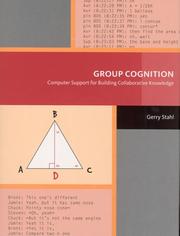
ISBN: 9786612096778 0262257025 128209677X 1423774507 0262195399 9780262195393 9780262257022 9781423774501 0262292629 6612096772 9781282096776 9780262292627 Year: 2006 Publisher: Cambridge, Massachusetts [Piscataqay, New Jersey] MIT Press IEEE Xplore
Abstract | Keywords | Export | Availability | Bookmark
 Loading...
Loading...Choose an application
- Reference Manager
- EndNote
- RefWorks (Direct export to RefWorks)
Innovative uses of global and local networks of linked computers make new ways of collaborative working, learning, and acting possible. In Group Cognition Gerry Stahl explores the technological and social reconfigurations that are needed to achieve computer-supported collaborative knowledge building--group cognition that transcends the limits of individual cognition. Computers can provide active media for social group cognition where ideas grow through the interactions within groups of people; software functionality can manage group discourse that results in shared understandings, new meanings, and collaborative learning. Stahl offers software design prototypes, analyzes empirical instances of collaboration, and elaborates a theory of collaboration that takes the group, rather than the individual, as the unit of analysis. Stahl's design studies concentrate on mechanisms to support group formation, multiple interpretive perspectives, and the negotiation of group knowledge in applications as varied as collaborative curriculum development by teachers, writing summaries by students, and designing space voyages by NASA engineers. His empirical analysis shows how, in small-group collaborations, the group constructs intersubjective knowledge that emerges from and appears in the discourse itself. This discovery of group meaning becomes the springboard for Stahl's outline of a social theory of collaborative knowing. Stahl also discusses such related issues as the distinction between meaning making at the group level and interpretation at the individual level, appropriate research methodology, philosophical directions for group cognition theory, and suggestions for further empirical work.
Computer networks. --- Computer-assisted instruction. --- CAI (Computer-assisted instruction) --- Computer-aided instruction --- Computer-assisted learning --- Computer based instruction --- Computer-enhanced learning --- Electronic data processing in programmed instruction --- ILSs (Integrated learning systems) --- Integrated learning systems --- Microcomputer-aided instruction --- Microcomputer-assisted instruction --- Microcomputer-assisted learning --- Microcomputer-based instruction --- Teaching --- Communication systems, Computer --- Computer communication systems --- Data networks, Computer --- ECNs (Electronic communication networks) --- Electronic communication networks --- Networks, Computer --- Teleprocessing networks --- Data processing --- Education --- Educational technology --- Programmed instruction --- Telematics --- Data transmission systems --- Digital communications --- Electronic systems --- Information networks --- Telecommunication --- Cyberinfrastructure --- Electronic data processing --- Network computers --- Distributed processing --- COMPUTER SCIENCE/Human Computer Interaction --- Computer-assisted instruction --- Computer networks --- #SBIB:309H103 --- #SBIB:309H1720 --- Mediatechnologie / ICT / digitale media: sociale en culturele aspecten --- Informatiekunde, informatie management
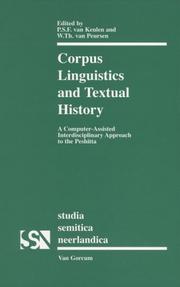
ISBN: 9023241940 9004358773 9789023241942 Year: 2006 Volume: 48 Publisher: Assen Van Gorcum
Abstract | Keywords | Export | Availability | Bookmark
 Loading...
Loading...Choose an application
- Reference Manager
- EndNote
- RefWorks (Direct export to RefWorks)
Over the years the use of computers for research has become increasingly important in Biblical Studies. However, a combination of computational linguistics with diachronic text-critical and text-historical approaches has hardly ever taken place. Quite often, there is mutual misunderstanding between computational linguistics and more traditional approaches in the field of linguistics and textual analysis. For example, in computer-assisted research of modern text corpora it is common to treat the text as an unequivocal and unidimensional sequence of characters. In Biblical Studies, however, either text is considered an abstraction, the result of a scholarly reconstruction based on the extant textual witnesses. Here a fundamental difference in approach reveals itself. The present volume tries to overcome the misunderstanding between the various disciplines and to establish how a fruitful interaction of information technology, linguistics and textual criticism, can contribute to the analysis of ancient texts. It addresses questions concerning the confrontation between synchronic and diachronic approaches, the role of linguistic analysis in the interpretation of texts, and the interaction of linguistic theory and the analysis of linguistic data. The first section of this volume contains the papers presented at the CALAP seminar 2003. In the second section different aspects of the interdisciplinary analysis are applied to a selected passage from the Peshitta of Kings.
Corpora (Linguistics) --- Criticism, Textual --- Bible. --- Versions --- Peshitta --- 221.014*2 --- 221.014*2 Oud Testament: geschiedenis van grondtekst en oude vertalingen --- Oud Testament: geschiedenis van grondtekst en oude vertalingen --- Corpus-based analysis (Linguistics) --- Corpus linguistics --- Linguistic analysis (Linguistics) --- Antico Testamento --- Hebrew Bible --- Hebrew Scriptures --- Kitve-ḳodesh --- Miḳra --- Old Testament --- Palaia Diathēkē --- Pentateuch, Prophets, and Hagiographa --- Sean-Tiomna --- Stary Testament --- Tanakh --- Tawrāt --- Torah, Neviʼim, Ketuvim --- Torah, Neviʼim u-Khetuvim --- Velho Testamento --- Hebrew language --- Computer-assisted instruction. --- CAI (Computer-assisted instruction) --- Computer-aided instruction --- Computer-assisted learning --- Computer based instruction --- Computer-enhanced learning --- Electronic data processing in programmed instruction --- ILSs (Integrated learning systems) --- Integrated learning systems --- Microcomputer-aided instruction --- Microcomputer-assisted instruction --- Microcomputer-assisted learning --- Microcomputer-based instruction --- Teaching --- Education --- Educational technology --- Programmed instruction --- Telematics --- Jewish language --- Jews --- Semitic languages, Northwest --- Data processing --- Data processing. --- Languages --- Computer-assisted instruction --- Palaia Diathēk --- Epic poetry, Greek Criticism, Textual --- Corpora (Linguistics) - Congresses. --- Criticism, Textual - Congresses.
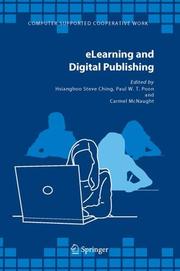
ISBN: 1402036515 140203640X 904816916X Year: 2006 Publisher: Dordrecht : Springer,
Abstract | Keywords | Export | Availability | Bookmark
 Loading...
Loading...Choose an application
- Reference Manager
- EndNote
- RefWorks (Direct export to RefWorks)
eLearning and Digital Publishing will occupy a unique niche in the literature accessed by library and publishing specialists, and by university teachers and planners. It examines the interfaces between the work done by four groups of university staff who have been in the past quite separate from, or only marginally related to, each other—library staff, university teachers, university policy makers, and staff who work in university publishing presses. All four groups are directly and intimately connected with the main functions of universities—the creation, management and dissemination of knowledge in a scholarly and reflective manner. This book provides a framework which clearly portrays the relationships between information literacy, eLearning and digital publishing. The structure of the book has three main sections: the first has primarily an educational focus, the second a focus on digital publishing, and the third builds on the first two sections to examine overall implications for the growth of knowledge and scholarly communication.
Internet in education. --- Computer-assisted instruction. --- Distance education. --- Electronic publishing. --- Digital publishing --- Online publishing --- Publishers and publishing --- Desktop publishing --- Distance learning --- Education --- Open learning --- Telecommunication in education --- Internet (Computer network) in education --- CAI (Computer-assisted instruction) --- Computer-aided instruction --- Computer-assisted learning --- Computer based instruction --- Computer-enhanced learning --- Electronic data processing in programmed instruction --- ILSs (Integrated learning systems) --- Integrated learning systems --- Microcomputer-aided instruction --- Microcomputer-assisted instruction --- Microcomputer-assisted learning --- Microcomputer-based instruction --- Teaching --- Educational technology --- Programmed instruction --- Telematics --- Data processing --- Information systems. --- Computer science. --- Information storage and retrieva. --- Information Systems and Communication Service. --- Models and Principles. --- Information Storage and Retrieval. --- Information Systems Applications (incl. Internet). --- Informatics --- Science --- Information storage and retrieval systems. --- Automatic data storage --- Automatic information retrieval --- Automation in documentation --- Computer-based information systems --- Data processing systems --- Data storage and retrieval systems --- Discovery systems, Information --- Information discovery systems --- Information processing systems --- Information retrieval systems --- Machine data storage and retrieval --- Mechanized information storage and retrieval systems --- Computer systems --- Electronic information resources --- Data libraries --- Digital libraries --- Information organization --- Information retrieval --- Computers. --- Information storage and retrieval. --- Application software. --- Application computer programs --- Application computer software --- Applications software --- Apps (Computer software) --- Computer software --- Automatic computers --- Automatic data processors --- Computer hardware --- Computing machines (Computers) --- Electronic brains --- Electronic calculating-machines --- Electronic computers --- Hardware, Computer --- Cybernetics --- Machine theory --- Calculators --- Cyberspace
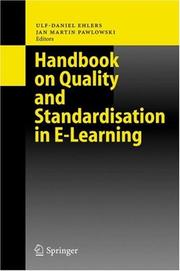
ISBN: 1280635134 9786610635139 3540327886 3540327878 3642069304 9783540327875 Year: 2006 Publisher: Berlin : Springer,
Abstract | Keywords | Export | Availability | Bookmark
 Loading...
Loading...Choose an application
- Reference Manager
- EndNote
- RefWorks (Direct export to RefWorks)
Quality and standardisation in e-learning have become crucial success factors for organisations in learning, education and training: E-Learning has changed from an ‘early adopter’ stage to an integrated part of learning scenarios leading to major changes in educational organisations towards quality orientation. For building a knowledge society, it is critically important to thoroughly understand quality and standards in e-learning. The handbook provides a cross-national perspective on these issues and draws a clear picture of the situation in quality development and standardisation. It covers topics of a rather foundational nature in quality and standardisation research as well as descriptions of quality approaches, instruments, standards, experiences and best practices. The Handbook is directed to learners, professionals, researchers and policy makers – people creating the next generation of learning.
Web-based instruction --- Internet in education. --- Computer-assisted instruction. --- Online instruction, Web-based --- Online teaching --- Web-based online instruction --- Computer-assisted instruction --- CAI (Computer-assisted instruction) --- Computer-aided instruction --- Computer-assisted learning --- Computer based instruction --- Computer-enhanced learning --- Electronic data processing in programmed instruction --- ILSs (Integrated learning systems) --- Integrated learning systems --- Microcomputer-aided instruction --- Microcomputer-assisted instruction --- Microcomputer-assisted learning --- Microcomputer-based instruction --- Teaching --- Education --- Educational technology --- Programmed instruction --- Telematics --- Internet (Computer network) in education --- Data processing --- Business mathematics. --- Information technology. --- Education. --- Business Mathematics. --- IT in Business. --- Educational Technology. --- Computers and Education. --- Children --- Education, Primitive --- Education of children --- Human resource development --- Instruction --- Pedagogy --- Schooling --- Students --- Youth --- Civilization --- Learning and scholarship --- Mental discipline --- Schools --- Training --- IT (Information technology) --- Technology --- Information superhighway --- Knowledge management --- Arithmetic, Commercial --- Business --- Business arithmetic --- Business math --- Commercial arithmetic --- Finance --- Mathematics --- Business—Data processing. --- Educational technology. --- Education—Data processing. --- Instructional technology --- Technology in education --- Educational innovations --- Instructional systems --- Aids and devices --- Data processing. --- 371 --- 371 Onderwijs. Schoolwezen --- Onderwijs. Schoolwezen --- Standards --- Computer uses in education --- Computers in education --- Educational computing --- Microcomputer uses in education --- Microcomputers in education --- Electronic data processing --- Courses, Online --- Online courses --- Online education --- Distance education
| Listing 1 - 10 of 10 |
Sort by
|

 Search
Search Feedback
Feedback About UniCat
About UniCat  Help
Help News
News